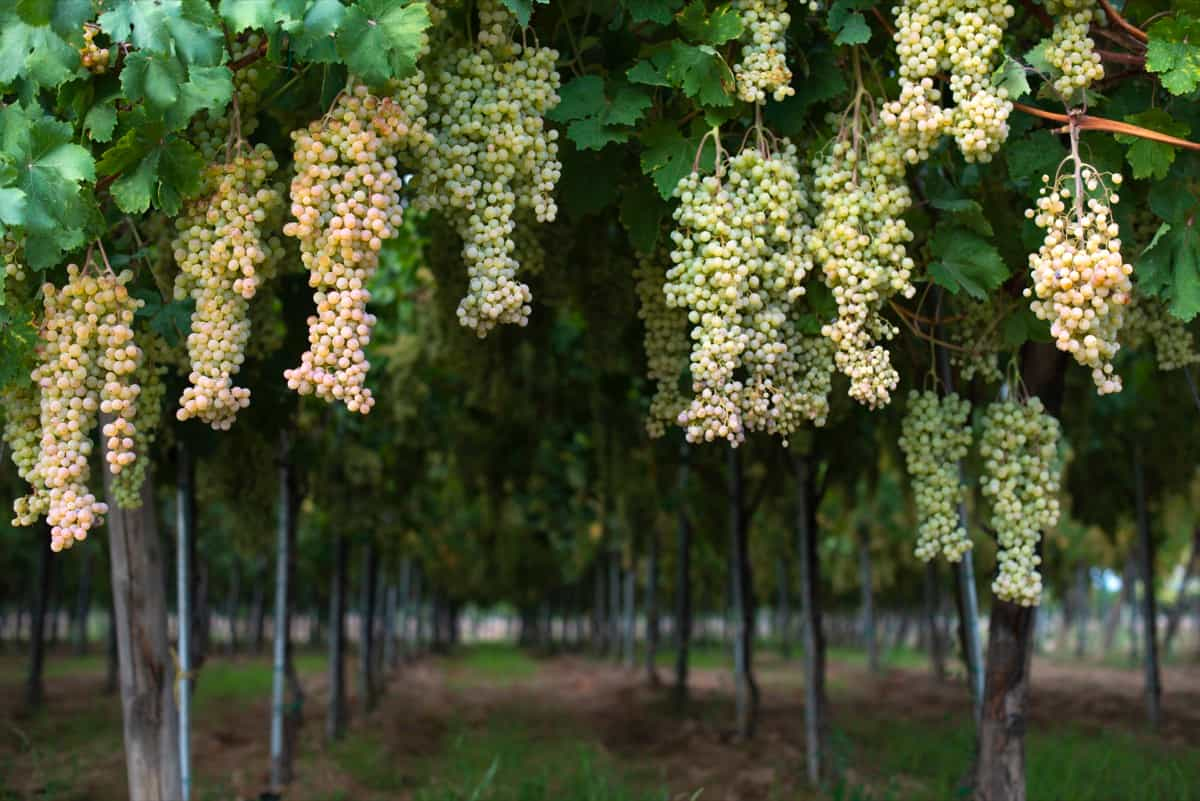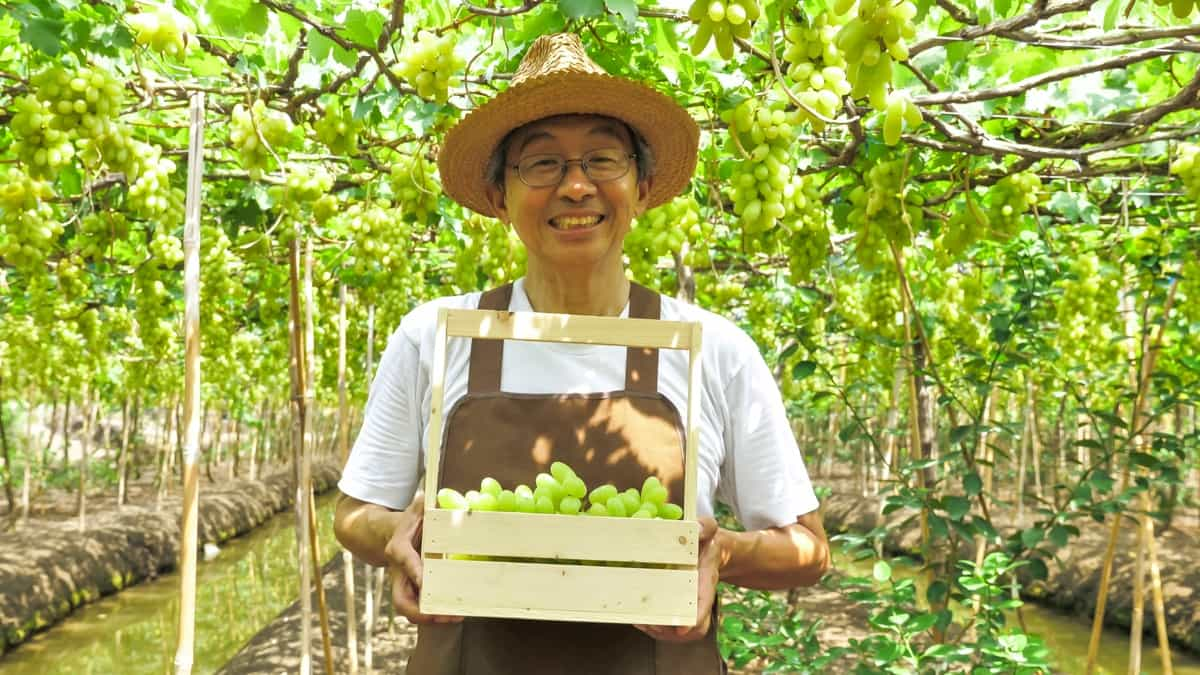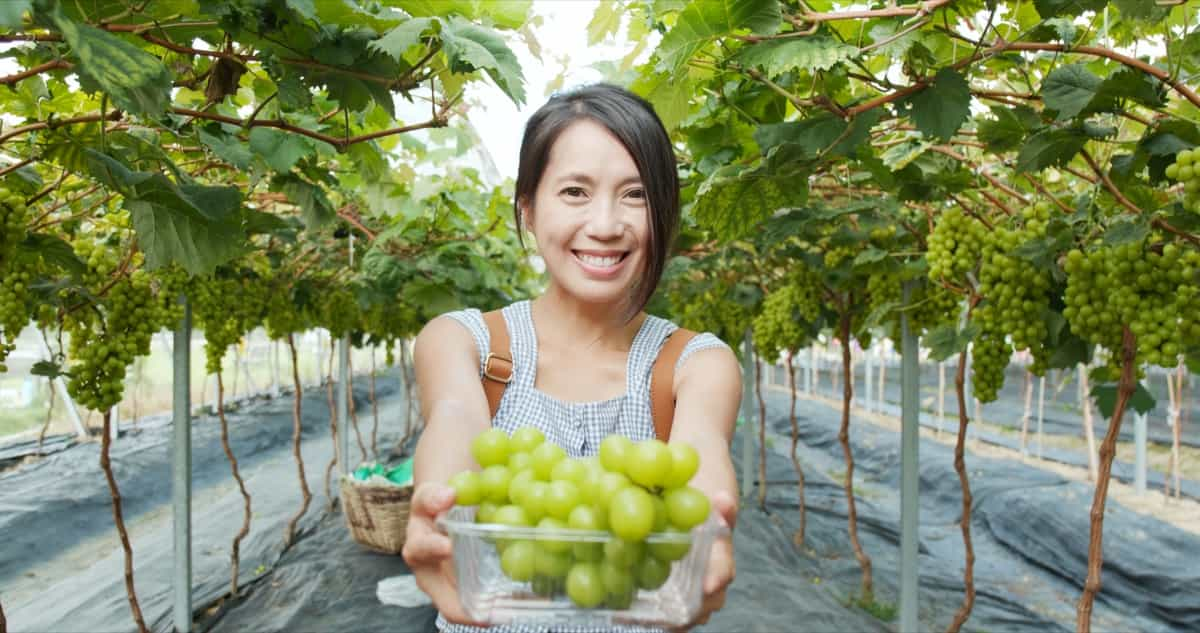Grapes are one of the most popular fruits in the world, but they are not native to the Philippines. However, some farmers have successfully grown grapes in the country, especially in La Union, which is known as the “grapes capital of the Philippines.” Grape farming can be a profitable venture, but it requires careful planning, proper site selection, suitable varieties, and good management practices. Here are some tips on how to start a grape farm in the Philippines.

Types and Varieties of Grapes in the Philippines
There are many types of grapes, but they can be classified into three groups: table grapes, wine grapes, and raisin grapes. Table grapes are eaten fresh or processed into juice, jam, or jelly. Wine grapes are used for making wine, vinegar, or brandy. Raisin grapes are dried to make raisins. The most common and popular varieties of grapes grown in the Philippines are Cardinal and Catawba. Cardinal is a red table grape with large, round, and juicy berries. It is early maturing and has a sweet flavor.
Catawba is a pinkish-red grape that can be used for table, wine, or juice. It has medium-sized, oval, and firm berries. It is late maturing and has a musky flavor. Other varieties that can be grown in the Philippines include Zante Currant, Concord, Sultana, Black Beauty, and Kyoho. Zante Currant is a black raisin grape with small, seedless, and sweet berries. Concord is a blue-black table or wine grape with large, round, and seeded berries.
It has a distinctive flavor and aroma. Sultana is a white raisin grape with small, seedless, and sweet berries. Black Beauty is a black table grape with large, round, and seedless berries. It has a crisp texture, mild flavor. Kyoho is a purple-black table grape with large, round, and seeded berries. It has a soft texture, rich flavor.
Grapes Growing Areas in the Philippines
Grapes can grow in various climates and soils, but they prefer warm, dry, and sunny conditions. They also need well-drained, loose, and deep soil with a pH of 6 to 7. The ideal elevation for growing grapes is between 100 to 500 meters above sea level.
The best areas for growing grapes in the Philippines are in Luzon, especially in La Union, Ilocos Sur, Pangasinan, Tarlac, Nueva Ecija, Pampanga, Bulacan, Batangas, Cavite, Laguna, Rizal, Quezon, Bataan, Zambales, and Metro Manila. Some areas in Visayas and Mindanao also have potential for grape production, such as Cebu, Iloilo, Negros Occidental, Bukidnon, Davao del Sur, and South Cotabato.
Irrigation Techniques for Optimal Grape Production in the Philippines
Grapes require adequate water supply during their growth stages, particularly during flowering, fruit set, and fruit development. Proper irrigation techniques are crucial for optimal grape production. Common methods include furrow irrigation, drip irrigation, and sprinkler irrigation. Furrow irrigation creates channels along grapevine rows but can cause water loss and soil erosion.
In case you missed it: Citrus Farming in the Philippines: Exploring Philipino Citrus Varieties to Growing Citrus Fruits

Drip irrigation delivers water to the root zone but can be expensive and complex. Sprinkler irrigation sprays water over grapevines but can also cause water loss and disease. The choice of irrigation method depends on factors like water availability, farm size, grapevine layout, soil type, climate, and maintenance requirements.
Controlling Common Grape Pests and Diseases in the Philippines
Grapes are vulnerable to pests, diseases that can significantly impact their quality and yield. Common pests include aphids, mealybugs, thrips, leafhoppers, mites, fruit flies, birds, rats, and bats. Common diseases include powdery mildew, downy mildew, anthracnose, botrytis rot, black rot, and leaf spot. Grape growers can use various methods to control these pests and diseases, including cultural, mechanical, biological, and chemical methods. Cultural Methods involve:
- Enhancing the health and resistance of grapevines through preventive practices like selecting resistant varieties.
- Using certified planting materials.
- Proper sanitation.
- Removing infected or infested plant parts.
- Mechanical methods involve physical or mechanical means to remove or exclude pests or diseases, such as handpicking, pruning, trapping, nets, screens, and mulches.
- Biological methods involve using natural enemies or beneficial organisms to control pests or diseases, such as introducing predators, pathogens, or botanical extracts. Chemical methods involve using synthetic or natural chemicals, such as insecticides, fungicides, herbicides, or growth regulators, to kill or suppress pests or diseases.
- The choice of control method depends on factors such as the type and severity of the pest or disease problem, the grapevine’s stage and condition, environmental and health impacts, and the cost and availability of control agents.
Pruning and Trellising Methods for Philippine Grape Varieties
Pruning and trellising are two important practices for grape production. Pruning involves cutting off excess or unwanted branches, leaves, buds, flowers, or fruits of the grapevines. Trellising involves providing support and direction for the growth of the grapevines. Pruning and trellising have several benefits for grape production, such as improving light penetration and air circulation, enhancing fruit quality and yield, reducing pest and disease problems, facilitating irrigation and fertilization, and making harvesting easier.
The best time to prune grapes in the Philippines is after harvesting, usually between November and January. The most common pruning system for grapes is cane pruning, which involves retaining one to two canes (long shoots) per vine, each with eight to 12 buds, and removing all other canes. The retained canes are then tied to a trellis wire for support.
In case you missed it: Pineapple Farming in the Philippines: Exploring Varieties to Cultivation Economics

The most common trellis system for grapes is a single-wire cordon, which involves using a single wire (usually 12-gauge galvanized iron) supported by posts (usually bamboo) spaced six to eight meters apart. The wire is placed about 1.5 meters above the ground. The grapevines are planted about three meters apart along the wire. The canes are trained horizontally along the wire in opposite directions.
Other pruning and trellising systems that can be used for grapes are spur pruning, which involves retaining short spurs (stubby shoots) with two to four buds per vine instead of long canes; double wire cordon, which involves using two wires instead of one; and arbor system, which involves using a wooden frame instead of a wire.
Common Grape Diseases and Pests in the Philippines
Grapes in the Philippines are susceptible diseases, pests that can affect their growth and quality. Common diseases include anthracnose, which causes dark spots on leaves, stems, and fruits, and downy mildew, which causes yellow spots and white fluffy growth. To prevent these, prune infected parts, apply fungicides, and avoid overhead irrigation.
Powdery mildew causes white powdery patches on leaves, stems, and fruits, reducing fruit size and quality. Mealybugs suck sap from grapes and secrete honeydew, attracting ants and fungi. To control mealybugs, apply insecticides, remove infested parts, and introduce natural enemies like ladybugs. Birds, which feed on ripe grapes, can cause significant crop damage. Deterring birds using nets, scarecrows, or noise devices is essential.
Government Grants for Grape Farming in the Philippines
Grape farming in the Philippines offers income and livelihood to many farmers but requires capital and technical assistance. Government grants like the Agricultural Competitiveness Enhancement Fund (ACEF) and the Philippine Rural Development Project (PRDP) can help. ACEF provides loans, grants, and scholarships for farm inputs, equipment, infrastructure, research, training, and marketing.
PRDP increase rural incomes and enhance farm competitiveness through improved access to markets, infrastructure, technology, and services. HVCDP promotes high-value crops like grapes, offering grants for seeds, fertilizers, pesticides, irrigation systems, post-harvest facilities, and capacity building.
Cost of Grape Farming in the Philippines
Grape farming in the Philippines is a profitable business that can generate income for farmers. However, it involves several costs, including land preparation, planting materials, trellis system, and irrigation system. Land preparation costs can range from ₱10,000 to ₱20,000 per hectare, depending on the size and condition of the land.
Planting materials cost between ₱5 to ₱10 per cutting or ₱100 to ₱200 per kilo of seeds. Trellis system costs between ₱20,000 to ₱40,000 per hectare, depending on the type and material used. The irrigation system costs between ₱10,000 to ₱30,000 per hectare. The initial investment for a one-hectare grape farm can range from P600,000 to P1.2 million, depending on the location and availability of resources.
Profitability of Grape Farming in the Philippines
Grape farming in the Philippines is a profitable business with high returns for farmers. Factors affecting profitability include market demand, grape quality, production costs, and management practices. Market demand is high, especially during peak seasons like summer and Christmas, with an average price of ₱200 to ₱300 per kilo.
Grape quality depends on various factors, including variety, climate, soil, irrigation, fertilization, pest control, pruning, and harvesting methods. Lower production costs lead to higher profit margins. Management practices, including choosing the right variety, site selection, planting density, training, pruning, irrigation, pest management, harvesting, and marketing strategies, also play a role in determining the yield and quality of grapes.
Best Month to Plant Grapes in the Philippines
Grapes are perennial plants that thrive in tropical countries like the Philippines, but specific months are more suitable for planting. January to March are the coolest months, providing optimal temperature and rainfall. June to August are rainy months with adequate moisture and humidity, and September to November are dry months with sufficient sunlight and heat for grape growth. Grape cuttings are readily available during these months.
In case you missed it: Beekeeping in the Philippines: Exploring Apiculture Industry in the Philippines

Organic Grape Farming Methods in the Philippines
Organic grape farming in the Philippines uses natural and organic inputs like compost, manure, vermicast, mulch, neem oil, chili-garlic spray, vinegar, baking soda, and beneficial insects to enhance soil fertility, control pests and diseases, and improve plant health. Organic grape farming has several benefits, including reducing environmental pollution, increasing biodiversity, saving costs, producing safer and tastier grapes, and meeting consumer demand.
However, it also faces challenges such as labor requirements, lower yield potential, market competition, and lack of technical support. To succeed in organic grape farming, best practices include choosing suitable varieties and planting materials, preparing the land, installing a trellis system, applying organic fertilizers and mulches, pruning and training vines, monitoring and managing pests and diseases, and harvesting and marketing the grapes.
Sustainable Grape Farming Practices in the Philippines
The best month to plant grapes in the Philippines is during the dry season, which usually lasts from November to April. The recommended spacing between plants is 1.5 meters, and between rows is 3 meters. Many types of grapes can grow in the Philippines, including Cardinal, Catawba, Black Beauty, and Kyoho. Bauang, La Union, is the grapes capital of the Philippines, where grape farming was started in 1972 by Avelino A. Lomboy. Today, there are over 100 hectares of grape farms in Bauang, producing about 10 tons of grapes per hectare per year.
In 2020, the Philippine Statistics Authority reported that grapes production in the Philippines was 5,841 metric tons, an 11.8% decrease from 6,624 metric tons in 2019. This decrease was attributed to the adverse effects of the COVID-19 pandemic, the Taal Volcano eruption, and typhoons.
Major grape-producing regions in 2020 were the Ilocos Region, Cagayan Valley, Central Luzon, CALABARZON, and Central Visayas. The average price for Cardinal was P250 per kilo, P300 per kilo for Black Beauty, P400 per kilo for Kyoho, and P500 per kilo for Catawba. However, these prices may change over time and across different locations.
In case you missed it: Sorghum Farming in the Philippines: A Step-by-Step Production Guide

Yield Potential of Grapes in Philippine Soil
The yield potential of grapes is influenced by the variety of grapes planted. There are three main types: table grapes, juice grapes, and wine grapes. Table grapes are seedless, large, sweet, and firm, while juice grapes have thicker skins and juicy flesh. Wine grapes are smaller, sweeter, and have thicker skins.
Successful grape varieties in the Philippines include Cardinal, Ribier, Perlette, Thompson Seedless, Black Beauty, Kyoho, Pione, Aki Queen, Rosario Bianco, Cotopy, Muscat Bailey-A, and Delaware. The yield potential varies depending on the variety, ranging from 700 to 1000 kilograms per 1000 square meters of land.
Black Beauty vs. Kyoho Grapes: Comparison for Philippine Farming
Black Beauty and Kyoho grapes are two varieties of grapes introduced to the Philippines from California, USA, and Japan. Both are known for their large size and dark purple color. Black Beauty grapes are seedless table grapes with a sweet and mild flavor, suitable for fresh consumption or making raisins. They can be harvested twice a year, from March to April and September to October.
Kyoho grapes are seeded juice grapes with sweet and juicy flesh, ideal for making jams, jellies, juices, or wines. Both grapes require similar growing conditions, such as sandy or loamy soils, good drainage, pH levels of 6 to 7, adequate sunlight, water, and fertilizer. However, Kyoho grapes may require more pruning and thinning to control their size and yield.
In case you missed it: How to Start Banana Farming in the Philippines: Business Plan, Varieties, Requirements, and Profit

Conclusion
In the Philippines, cultivating grapes presents both challenges and opportunities. The tropical climate demands strategic planting and care methods. Initial costs encompass vine establishment and maintenance. Successful grape farming in the Filipino climate necessitates meticulous planning, mindful resource allocation, and adherence to scientific cultivation practices.
- Types of Pesticides Used in Agriculture: A Beginner’s Guide
- Economical Aquaculture: A Guide to Low-Budget Fish Farming
- 15 Common Planting Errors That Can Doom Your Fruit Trees
- How to Make Houseplants Bushy: Effective Tips and Ideas
- Innovative Strategies for Boosting Coconut Pollination and Yield
- Pollination Strategies for Maximum Pumpkin Yield
- The Complete Guide to Chicken Fattening: Strategies for Maximum Growth
- Natural Solutions for Tulip Problems: 100% Effective Remedies for Leaf and Bulb-Related Issues
- Revolutionizing Citrus Preservation: Towards a Healthier, Greener Future
- Natural Solutions for Peony Leaf and Flower Problems: 100% Effective Remedies
- Maximizing Profits with Avocado Contract Farming in India: A Comprehensive Guide
- Natural Solutions for Hydrangea Problems: 100% Effective Remedies for Leaf and Flowers
- The Ultimate Guide to Choosing the Perfect Foliage Friend: Bringing Life Indoors
- From Sunlight to Sustainability: 15 Ways to Use Solar Technology in Agriculture
- The Ultimate Guide to Dong Tao Chicken: Exploring from History to Raising
- The Eco-Friendly Makeover: How to Convert Your Unused Swimming Pool into a Fish Pond
- Mastering the Art of Delaware Chicken Farming: Essentials for Healthy Backyard Flocks
- 20 Best Homemade Fertilizers for Money Plant: DIY Recipes and Application Methods
- How to Craft a Comprehensive Free-Range Chicken Farming Business Plan
- Brighten Your Flock: Raising Easter Egger Chickens for Beauty and Bounty
- How to Optimize Your Poultry Egg Farm Business Plan with These Strategies
- Subsidy for Spirulina Cultivation: How Indian Government Schemes Encouraging Spirulina Farmers
- Ultimate Guide to Raising Dominique Chickens: Breeding, Feeding, Egg-Production, and Care
- Mastering the Art of Raising Jersey Giant Chickens: Care, Feeding, and More
- Ultimate Guide to Raising Legbar Chickens: Breeding, Farming Practices, Diet, Egg-Production
- How to Raise Welsummer Chickens: A Comprehensive Guide for Beginners
- How to Protect Indoor Plants in Winter: A Comprehensive Guide
- Ultimate Guide to Grow Bag Gardening: Tips, Tricks, and Planting Ideas for Urban Gardeners
- Guide to Lotus Cultivation: How to Propagate, Plant, Grow, Care, Cost, and Profit
- Agriculture Drone Subsidy Scheme: Government Kisan Subsidy, License, and How to Apply Online
- Ultimate Guide to Raising Araucana Chickens: Breed Profile, Farming Economics, Diet, and Care
- Bringing Hydroponics to Classroom: Importance, Benefits of Learning for School Students
- Ultimate Guide to Raising Polish Chickens: Breed Profile, Farming Economics, Diet, and Care
- Ultimate Guide to Raising Australorp Chickens: Profile, Farming Economics, Egg Production, Diet, and Care
- Silkie Chicken Farming: Raising Practices, Varieties, Egg Production, Diet, and Care
- Sussex Chicken Farming: Raising Practices, Varieties, Egg Production, Diet and Care